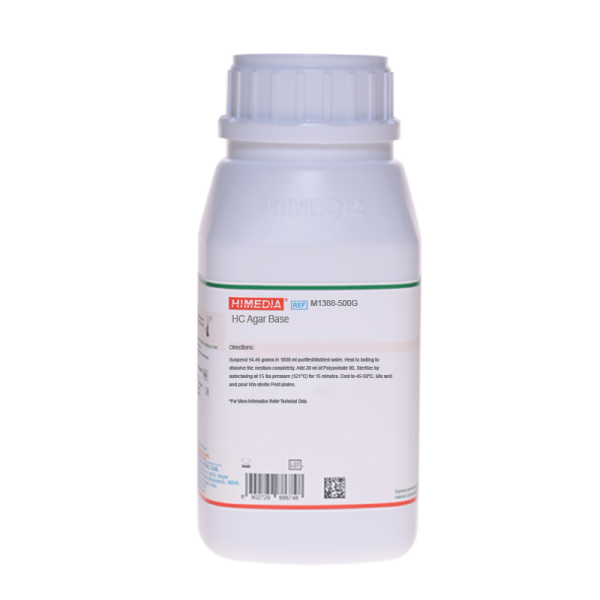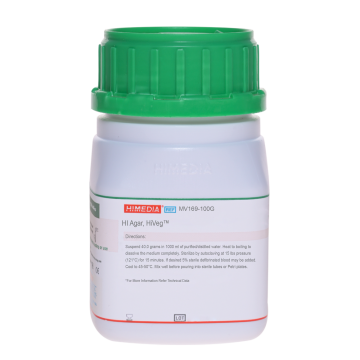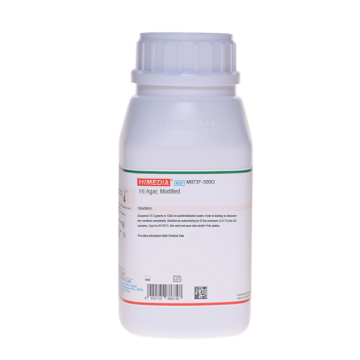 Your enquiry has been submitted
Your enquiry has been submitted
HC Agar Base
Estimating Counts of Fungi - Yeasts and Molds#CC293D
Intended use
Recommended for enumeration of moulds in cosmetic products when supplemented with Polysorbate 80.
Composition
| Ingredients | Gms / Litre |
|---|---|
| Tryptone | 2.500 |
| Proteose peptone | 2.500 |
| Yeast extract | 5.000 |
| Dextrose (Glucose) | 20.000 |
| Disodium hydrogen phosphate | 3.500 |
| Potassium dihydrogen phosphate | 3.400 |
| Ammonium chloride | 1.400 |
| Magnesium sulphate | 0.060 |
| Sodium carbonate | 1.000 |
| Chloramphenicol | 0.100 |
| Agar | 15.000 |
Final pH (at 25°C): 7.0±0.2
Formula adjusted, standardized to suit performance parameters
Directions
Suspend 54.46 grams in 1000 ml purified/distilled water. Heat to boiling to dissolve the medium completely. Add 20 ml of Polysorbate 80. Sterilize by autoclaving at 15 lbs pressure (121°C) for 15 minutes. Cool to 45-50°C. Mix well and pour into sterile Petri plates.
Principle And Interpretation
Cosmetics do not need to be sterile but they must be adequately preserved. Microbial contamination to cosmetics is a substantial risk to product quality, regulatory compliance and consumer health (1). HC Agar Base, formulated by Mead and ONeill, is used for enumerating moulds in cosmetic products (5). This medium differs from the traditionally used media for testing cosmetics products by addition of Polysorbate 80 and incubation time of 3 days, rather than 7 days, at 27°C ± 0.5°C to obtain a significant mold count (2).
HC Agar Base contains tryptone and proteose peptone, which serve as sources of carbon, nitrogen, vitamins and minerals. Yeast extract acts as a source of B-complex vitamins that helps to stimulate bacterial growth. Dextrose serves as a source of energy by being the fermentable carbohydrate. Ammonium chloride and magnesium sulphate provide essential ions. Phosphates buffer the medium. Sodium carbonate helps to inactivate the low levels of preservatives if present (e.g. benzoic acid). Chloramphenicol inhibits accompanying bacteria, including Pseudomonas aeruginosa and Serratia marcescens. Polysorbate 80 also neutralizes preservatives and sequesters surfactants that may be present in the sample (5).
Type of specimen
Cosmetic products
Specimen Collection and Handling
After use, contaminated materials must be sterilized by autoclaving before discarding.
Warning and Precautions
Read the label before opening the container. Wear protective gloves/protective clothing/eye protection/ face protection. Follow good microbiological lab practices while handling specimens and culture. Standard precautions as per established guidelines should be followed while handling specimens. Safety guidelines may be referred in individual safety data sheets.
Limitations
- The 27±0.5°C incubation temperature is critical for obtaining scrupulously significant mold counts after three days.
- Individual organisms differ in their growth requirement and may show variable growth patterns on the medium.
Performance and Evaluation
Performance of the medium is expected when used as per the direction on the label within the expiry period when stored at recommended temperature.
Quality Control
Appearance: Pale yellow to beige homogeneous free flowing powder
Gelling: Firm, comparable with 1.5% Agar gel
Colour and Clarity of prepared medium: Medium amber coloured with yellow tinge, clear to slightly opalescent gel forms in Petri plates
Reaction: Reaction of 5.44% w/v aqueous solution at 25°C. pH: 7.0±0.2
pH: 6.80-7.20
Cultural Response: Cultural characteristics observed after an incubation at 27.5 ± 0.5°C for 65-72 hours.
| Organism | Growth |
|---|---|
| #Aspergillus brasiliensis ATCC 16404 (00053*) | good |
| Pseudomonas aeruginosa ATCC 27853 (00025*) | none-poor |
| Serratia marcescens ATCC 8100 | none-poor |
* Key: Corresponding WDCM numbers. #Formerly known as Aspergillus niger
Storage and Shelf Life
Store dehydrated and the prepared medium at 15-25°C. Use before expiry date on the label. On opening, product should be properly stored dry, after tightly capping the bottle in order to prevent lump formation due to the hygroscopic nature of the product. Improper storage of the product may lead to lump formation. Store in dry ventilated area protected from extremes of temperature and sources of ignition. Seal the container tightly after use. Product performance is best if used within stated expiry period.
Disposal
User must ensure safe disposal by autoclaving and/or incineration of used or unusable preparations of this product. Follow established laboratory procedures in disposing of infectious materials and material that comes into contact with sample must be decontaminated and disposed of in accordance with current laboratory techniques (3,4).
Reference
- Brannan D. K., (Ed.), Cosmetic Microbiology, A Practical Handbook, CRC Press
- FDA Bacteriological Analytical Manual, 2005, 18th Ed., AOAC, Washington, D.C.Composition
- Isenberg, H.D. Clinical Microbiology Procedures Handbook 2nd Edition
- Jorgensen, J.H., Pfaller, M.A., Carroll, K.C., Funke, G., Landry, M.L., Richter, S.S and Warnock., D.W. (2015) Manual of Clinical Microbiology, 11th Edition. Vol. 1.
- Mead C. and ONeill J., 1986, J. Soc. Cosmet Chem., 37:49-5
| Product Name | HC Agar Base |
|---|---|
| SKU | M1388 |
| Product Type | Regular |
| Physical Form | Powder |
| Origin | Animal |
| Packaging type | HDPE |
| References | 1.Brannan D. K., (Ed.), Cosmetic Microbiology, A Practical Handbook, CRC Press2.Mead C. and ONeill J., 1986, J. Soc. Cosmet Chem., 37:49-57.3.FDA Bacteriological Analytical Manual, 2005, 18th Ed., AOAC, Washington, D.C.Composition ** |
| Customized Product Available | No |








